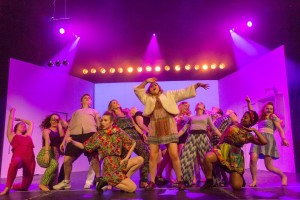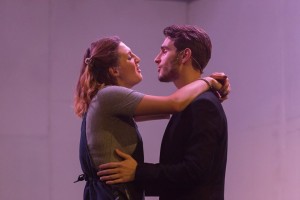Ghost Sound Design
- Backstage Soc

- Oct 4, 2015
- 3 min read
As soon as the designers’ call came out for Ghost, I knew I wanted to get involved with a show which has such a musically interesting, emotional score. Despite being a new member of Backstage, I was fortunate enough to be able to co-sound design with Kat!
As you will have noticed if you crewed or came and saw the show, you will have noticed the lack of band in the usual place at the front of the Riley stage. I knew the production team wanted the band to be in flies backstage and bringing this into consideration had to be the starting point of the design. With the band in flies, I had to think about how the band would be heard by the audience and secondly, how the band would hear each other as well as hearing the cast. I wanted to make the band as “electric” and acoustically silent as possible, reducing the amount of acoustic sound that could spill onto the stage from one side, which would’ve sounded out of place. All the guitars, keyboards and drums passed through DI boxes (Direct Input) which were connected straight to our mixer, completely avoiding using amplifiers in the pit, leaving just the strings and wind instruments making actual acoustic noise in flies! This obviously left a problem about how the band could hear each other! For the first time for a few years, we decided to give each member of the band an individual headphone mix, allowing each player the flexibility to choose how much of each instrument or singers they wanted to hear. To achieve this, we had to borrow a couple of headphone amplifiers from LSR, whilst also using all the sends on our multicore.
The desk of choice was the Si Compact 24 – a desk BSS will come more and more accustomed with as we move into the “Refec Riley”. Using this digital desk allowed us add effects such as compression, gates and graphic EQ to every send, to have full control over all our aux sends (10 headphone mixes, 4 groups (Radio Mics, Ambients, Band and Playback)), as well as allowing the faders to be arranged to make it as easy as possible to mix.
For Ghost, I set up a network in the Riley to allow us to have control over the projectors, as well as being able to network the sound desk giving us access to the Soundcraft iPad app, which let us control the sound desk from anywhere in the room. This was particularly useful when setting up the headphone mixes for the band, as we could sort them all out whilst being in flies by being with each band member as we mixed them.
In terms of mic-ing the cast, due to budget we decided to use four radio microphones, an SM58 in each wing for off stage singing and using all of our ambients. Whilst it would’ve been ideal to have more radio microphones, having the band isolated allowed us to bring the mix right down when cast members without microphones had solo lines and once fully rung out, the ambients can provide a lot to the overall sound!
Ghost allowed us to experiment with putting the band in an unusual place, using in ear headphone mixes, more video monitors and networking the Riley, giving people the chance to use new pieces of kit, whilst also contributing to one of the most exciting shows I’ve worked on! If you have any questions about the Ghost sound design or anything about sound in general, don’t hesitate to get in touch with me on Facebook or by email (chrismorris.a@gmail.com).
By Chris Morris
Posted on 5th December 2015
%20white%20text%20tra.png)



Comments